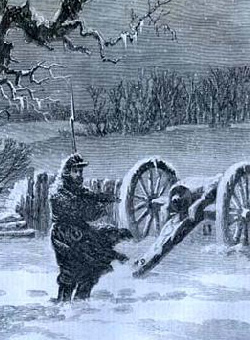
Please send all Checks and Money orders to :
Dave Taylor P.O. Box 87 Sylvania, OH 43560
419-842-1863
Click Here to E-mail Us!

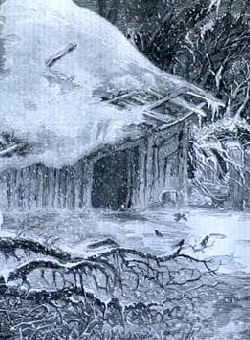
16-01-01

16-01-01 … RARE SPRINGFIELD TYPE-1 MODEL 1817 ARTILLERY/CADET MUSKET … Chief of Ordnance Decius Wadsworth initially ordered production of these shorter, lightweight muskets for cadet use in January, 1817, but felt them also suitable for artillery use and designated them “Artillery muskets.” 200 were sent to West Point in 1818, but the remainder of the production run at Springfield and Harpers Ferry went to artillery units. Only a few hundred were made each year. Flayderman estimates only 1,039 at Springfield until the last of them was assembled there in 1821. At Springfield the superintendent made it a point to use musket barrels that had defects at the muzzle, and both arsenals made it a point to use obsolete parts in fabricating the guns. We referenced Andrew Moller’s book American Military Shoulder Arms for in depth data. This is the Type-1 in Moller’s terminology, the earliest and scarcest pattern, and the one Moller feels was sent to West Point in 1818.
One key diagnostic feature is the use of just two barrel bands and the fitting of the upper sling swivel through the wood below the upper band in the British fashion. A second indicator is that the lock is the early iron pan lock with a flat beveled plate that also shows up on the transitional 1812-1816 Springfields. The plate has a clear “Spring/field/1817” stamp behind the hammer and an eagle over US forward, the correct early “P/(eaglehead)/V” proof and view marks on the left breech of the barrel. Tand is dated 1818. The breechplug tang has an 1818 date, which is fine, indicating the gun was likely assembled early that year. The musket was converted to percussion using the arsenal cone-in-barrel method. The flashpan was ground flush to the plate and a brass insert mounted at the cut-out of the plate, but the pan itself was plainly iron and integral to the plate. The gun is in untouched attic condition- the way I like them. The wood is dark with some minor dings and scratches, some slight shrinkage under the buttplate, but nothing bad. The metal is uniformly a plum brown patina with just some lighter brown and silver gray peeking through at the breech and on the side plate. The original rod, is present, as are the sling swivels, etc. Moller states that only a few examples are known and two of them are in the West Point Museum. This is a very scarce gun and one of the few real artillery muskets I have seen in my 45 years of collecting. This was collected-up long ago, by a very knowledgeable Michigan collector who sells me a few guns every year as he thins out … Here’s a chance to snag a true rarity in the field of early US shoulder arms … aa … $1,595.00 – SOLD
Call us @ 419-842-1863
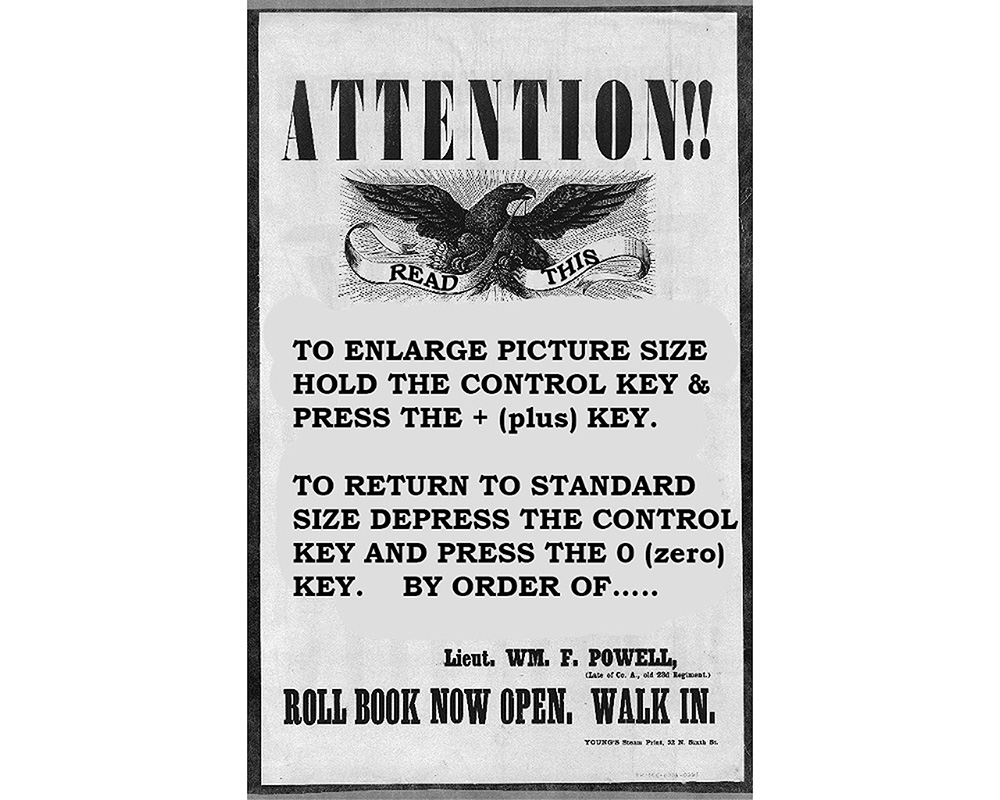

16-01-02 … FRENCH MODEL 1822 CAVALRY SABER … This is the granddaddy of our 1840 and 1860 pattern cavalry sabers. French military fashion was all the rage and we copied their uniforms and weapons alike. This has a hefty three branch brass guard and wire bound, leather wrapped grip. Maker and inspector marks are on the guard, ricasso and scabbard, as well as rack numbers and unit marks. The back of the blade shows the model year and 1880 date of manufacture at Chatterault, one of the big French arsenals. The hilt has a mellow patina. The wire and leather are complete. The blade has a typical unstopped fuller, and shows bright mixed with slightly duller silver tones, with good edge and point. The scabbard is a slightly duller gray with some darker spots, with single sling ring and drag in place. A nice addition to a cavalry or edge weapons collection. A heck of a lot of saber for very little money … ajj-mil … $295.00 – SOLD
Call us @ 419-842-1863
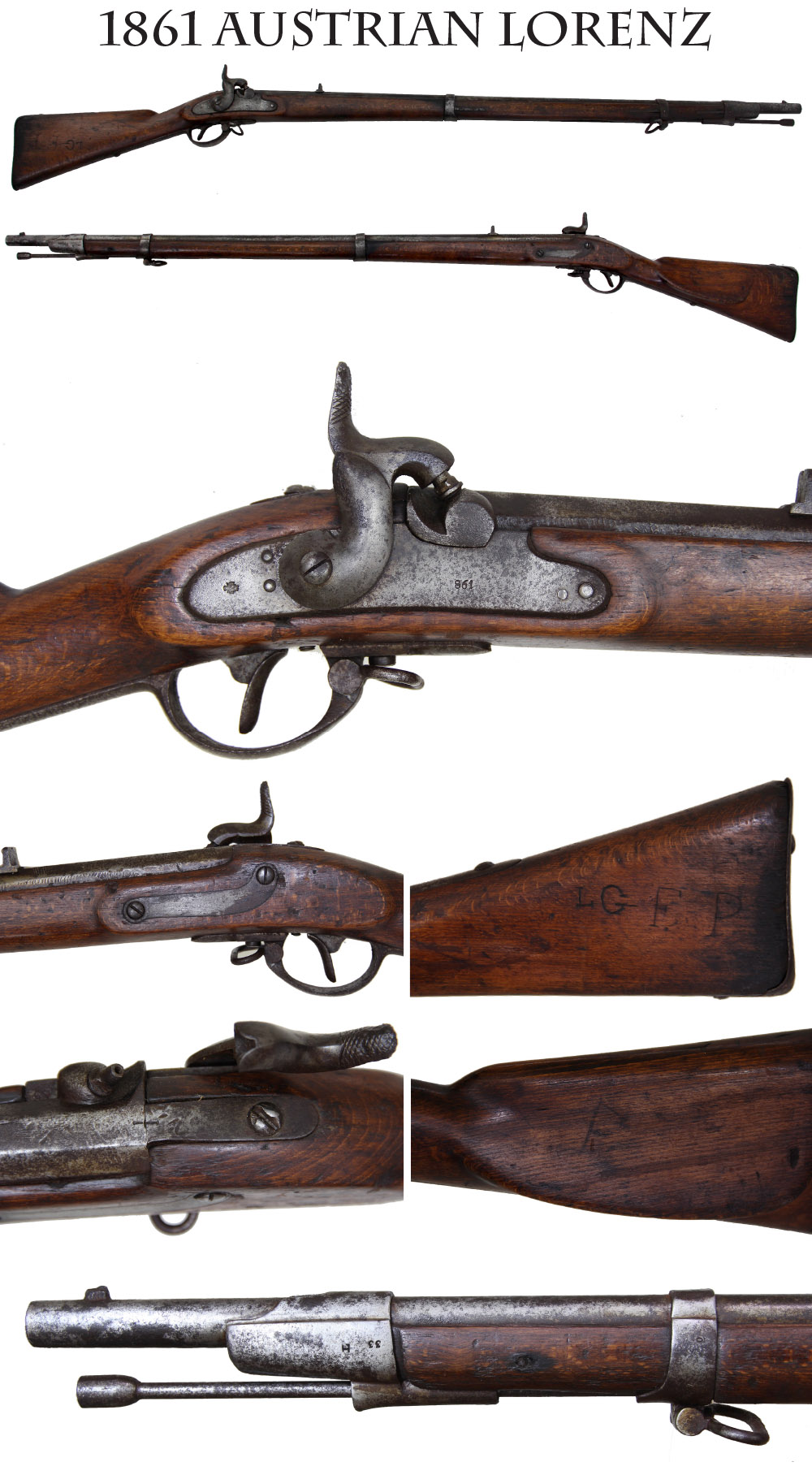
16-01-03 … 1861 DATED AUSTRIAN LORENZ RIFLE … The Austrian Lorenz was imported into this country by the north and the south in numbers second only to the British Enfield and was well liked by the soldiers carrying it. Ours has the typical three digit lock date- in this case “861” (1861) indicating it was one of the newer weapons brought over. Caliber .54. The front sight blade is a bit worn, but has the typical angled oval base for the spiral socket of the quadrangular bayonet, and a fixed block rear sight. The stock has its characteristic cheek rest on the left and shows the warmer gold tones of the European beech wood. The metal is generally dull silver/gray mixed with some darker gray areas, smooth, but with some speckling on the rear of the lockpate and a few vise marks near the breech. The metal shows the usual maker, assembly and inspector marks. The initials “LG FP” are carved in one side of the butt, and the letter “F” on the other, which are probably the addition of now unknown Yankee or Confederate soldier. The rod is period but not a Lorenz rod. All sling swivels, springs, etc. in place. Mechanically good. Decent bore. A real Civil War musket used widely by both sides, including the Wisconsin Iron Brigade and numerous Reb regiments from Tennessee … xxg … $1,150.00 – SOLD
Call us @ 419-842-1863

16-01-04 … PRESCOTT REVOLVER … Short-frame Prescott pocket model revolver, six-shot, .32 caliber rimfire with four inch barrel. Prescott made several different patterns of this revolver, but Flayderman estimates only a few hundred of each. Ours is numbered 184 on the barrel, cylinder and cylinder pin/ejector rod. Standard “E.A. Prescott Worcester, Mass. Pat. Oct. 2, 1860” barrel marks, with flat butt, cylinder locking notches, and spring latch for center pin doubling as ejector rod. Metal is an attractive greyish plum patina and very uniform. The brass frame has a handsome undisturbed age patina that all collectors look for. Grips are very pleasing color and rate excellent. A nice rimfire pocket revolver perfect for a Civil War or early western collection. 100% original, 100% complete, and mechanically excellent … bjj-17067 … $645.00 – SOLD
Call us @ 419-842-1863

16-01-05 … REGULATION CIVIL WAR MUSICIAN’S SWORD … US Model 1840 made in 1862. These straight bladed swords were carried by company and regimental musicians. This is the standard issue with 28 inch blade, made and marked by Ames Manufacturing Co. in their scroll style logo. The other side of the ricasso is deeply stamped US / GWC / 186_. The last digit of the date was never struck. We see this about one time in 40. The D-guard is inspected J.H. The underside of the quillon is inspected HDH. Taking data from http://proofhouse.com/cm/us_inspector.htm we see that JH is Joseph or John Hannis who both worked in 1862. HDH is Henry D Hastings who worked in 1862. Also GWC is George W. Chapin, he also worked in 1862. The drag bears matching inspector’s mark GWC. The blade exhibits 95% brilliant factory luster. Truly outstanding. The leather scabbard is solid and has a repair to a break about four inches north of the drag, and some spots where the leather finish has flaked off near the drag. Otherwise fine … bej-key … $350.00 – SOLD
Call us @ 419-842-1863
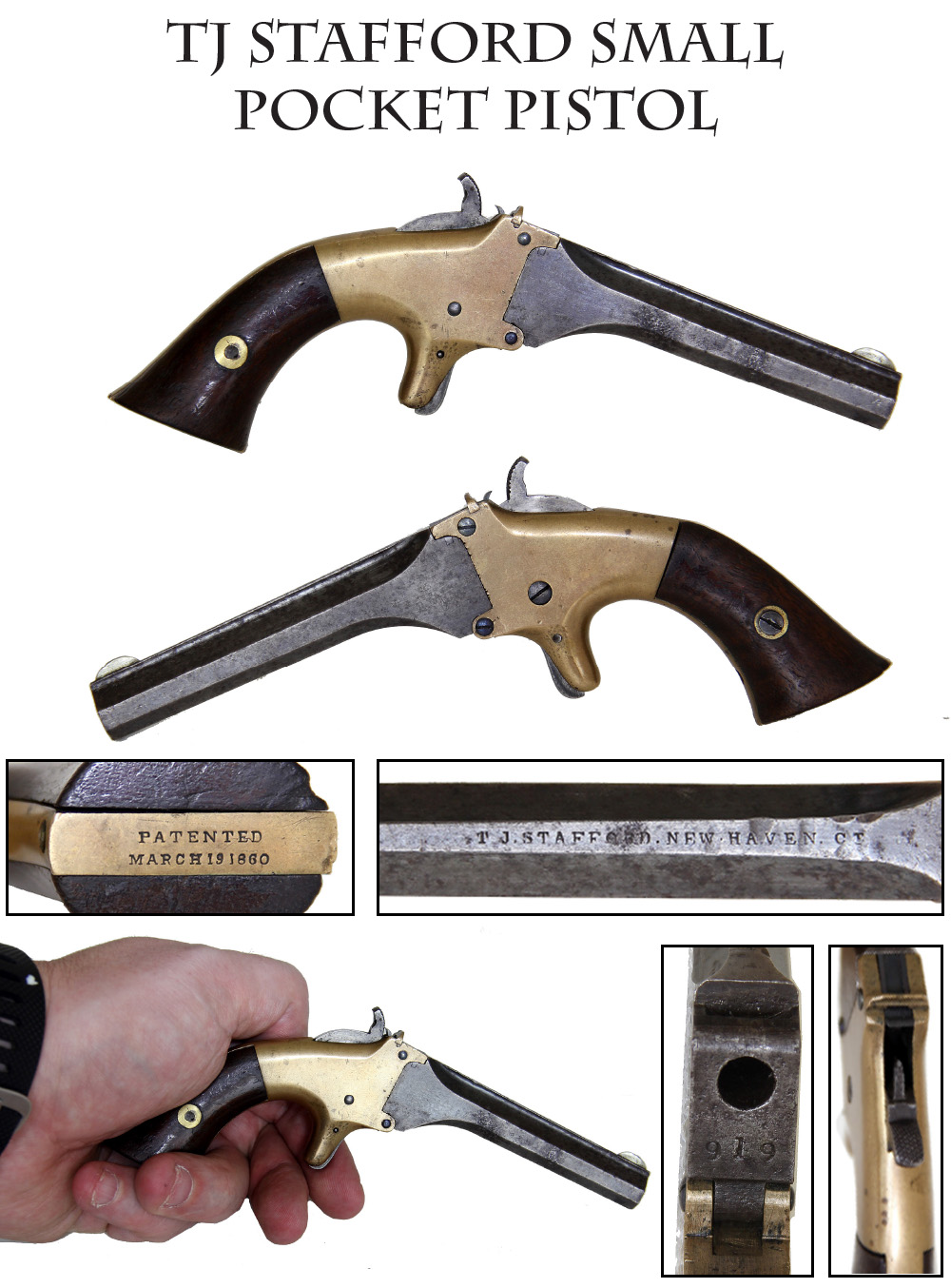
16-01-06 … T.J. STAFFORD SINGLE SHOT DERINGER … Only about 2,100 of these small pocket pistols were made in the early 1860s. Chambered for .22 rimfire cartridges, these single-shot pistols are last ditch weapons of personal defense and are really derringers. Very simple and sturdy construction: the barrel tips forward for loading and there is a shallow spur trigger. Front and rear sights in place, though to be effective you probably had to be within spitting distance of your target, or perhaps just a poker table’s width away. Barrel is blue faded to gray overall, smooth with a couple of minor dings on the edge of the top flat, and two patches of light pitting on the right flat, but a legible TJ Stafford, New Haven Ct. barrel stamp and crisp March 19 1860 patent date on the bottom of the brass butt strap. Grips are good, with minor dings and some small edge chips, but nice dark color. Frame is brass with a mellow patina. Serial number 919 on the face of the barrel chamber. A nice little derringer … bbe … $345.00 – SOLD
Call us @ 419-842-1863

16-01-07 … STARR 1818 INFANTRY/ARTILLERY SWORD … These Nathan Starr swords have a somewhat short 26-inch blade, but some width, giving them a good heft. Starr contracted with the Ordnance Department for some 4,000 of these in late 1818 and they were delivered over the next two years. Straight blade with spear point and false edge, unstopped fuller, iron guard with back strap and birdshead pommel, and knucklebow pierced for a sword knot. Iron scabbard with stud for a frog at the throat. Rather crude spear tip drag. Originally painted black, the scabbard and hilt are now gray with some darker areas. A few dents and dings to the scabbard, but no bends or breaks. Grip is covered with leather, a modern replacement. No bumper pad is present at the hilt. Very legible blade markings, “N. STARR over a US and “P” proved mark with the script “S” initial of an inspector who, so far as I know, has not yet been identified. Some have suggested that it is a state or private inspection mark, possibly even by Starr himself for swords that went elsewhere than the government despite the US mark. These are usually taken to be the successor to the 1813 NCO or Sergeant’s sword, but sources indicate Starr thought of them as swords for artillerymen. I have heard it suggested by some collectors they may have been used as musician’s swords as well. A scarce US sword, especially with its scabbard and nearly 200 years old … baj-jpal … $435.00 – SOLD
Call us @ 419-842-1863
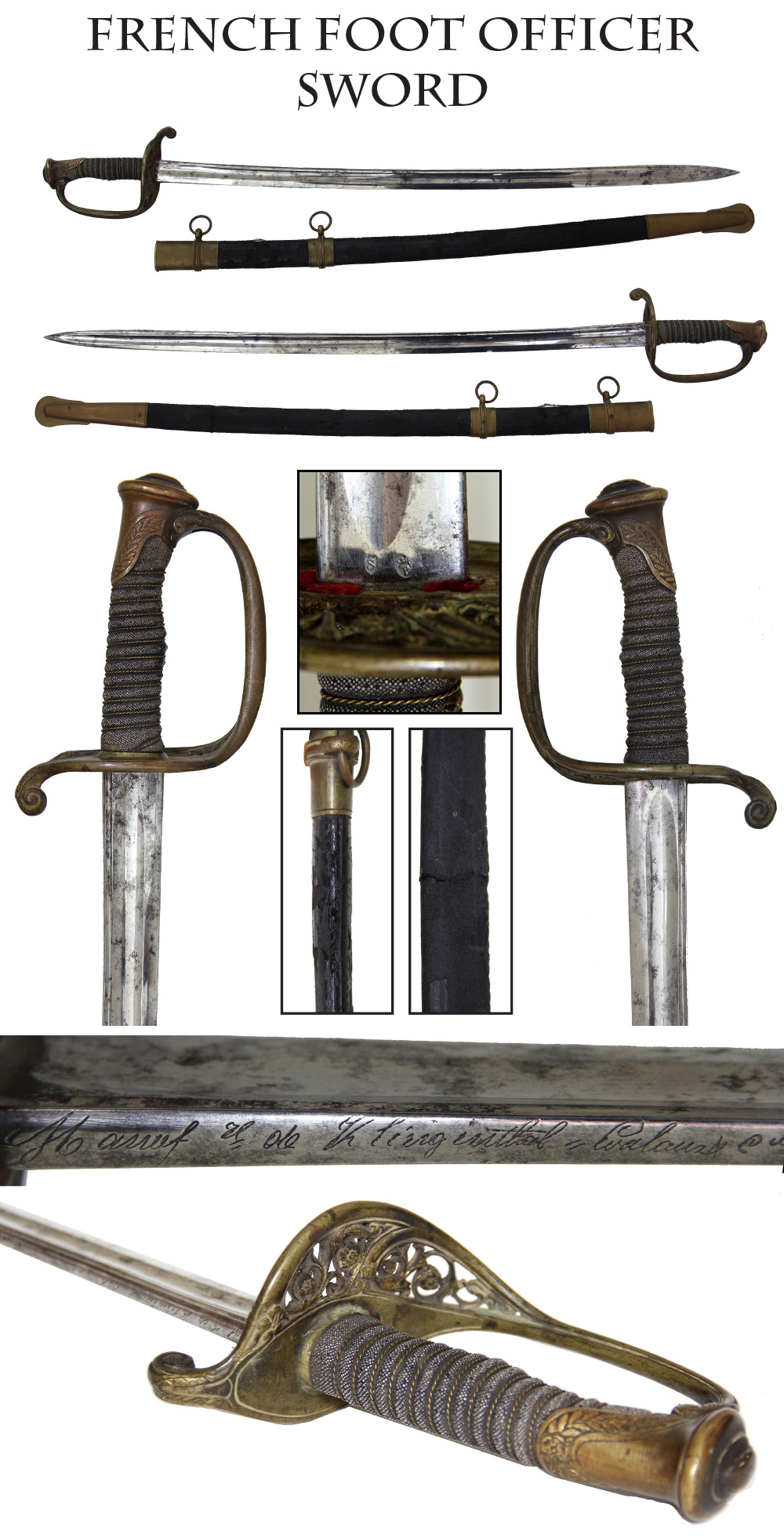
16-01-08 … KLINGENTHAL MADE FOOT OFFICER’S SWORD … We patterned our 1850 officer’s swords on the French patterns, and this one made by the Coulaux brothers at Klingenthal shows just how close they were in design. When the war started, European makers were not slow to cash in on the market. The Coulaux family made swords for the French armies from the time of Napoleon Bonaparte up through the 20th century. This is one of their 1860 era products and it turned up in NW Ohio early in 2015. Nice black leather scabbard with brass drag, middle and upper mounts. There is much flaking on the leather finish. The scabbard is tight and solid. Brass guard with foliate decoration, brass pommel cap, sharkskin grip with wire binding. Remnants of a red velvet pad at the blade shoulder. Nice blade, showing about 80 percent bright with just some graying. Inspector and maker marks on the ricasso and back of the blade. No motifs in the guard or etched on the blade to identify it with one nation or the other. Thillman, Civil War Army Swords, shows a similar Klingenthal foot officer’s sword with no motifs that has a dead-real inscription to an officer in the 89th New York on page 340. A handsome and affordable Civil War officer’s sword … cbe-130504-mnsfd … $495.00 – SOLD
Call us @ 419-842-1863

16-01-09 … UNTOUCHED, UNMOLESTED, ATTIC MINT HEAVY CAVALRY SABER … This 1840 pattern heavy cavalry saber turned up here in Toledo just last month … a fresh find. And it looks like it just came down from the attic. Beautiful uniformly warm, untouched patina. Mellow bronze tone to the brass, extremely handsome. Wire wrap in place on the grip. Original leather with just some light abrasion from the wire rubbing on it. Completely unmarked and with a uniform age-brown color to the blade. Not abused. No edge nicks or broken tip. Just untouched. Even the leather washer is still there. Countless times I have seen a beautiful relic like this destroyed by a well-intentioned descendant who decided to shine it up on the grinder in the basement. It’s a pleasure to see one unmessed-with since the war. This is a wonderful Civil War relic, it screams to tell a story but is unfortunately mute. It would look great on the wall … noco … $275.00 – SOLD
Call us @ 419-842-1863

16-01-10 … THREE INFANTRY CORPORALS OF THE 8th CORPS … Very nicely presented roughly quarter-plate (4 x 2.5 inches actual) tintype of three corporals, one standing and two seated. Their chevrons have been delicately tinted light blue, indicating infantry, and their trousers are also wonderfully tinted light blue. All wear forage caps and state issued sack coats, and have the no-nonsense facial expressions of veteran campaigners. (Note the squared bottoms on the blouses as opposed to the rounded bottoms on federal issue blouses.) Two of the men wear the eight-pointed star of the 8th Corps and the seated corporal on the left has also pinned a circular badge of some sort in the angle of his corporal’s chevrons. He is turned slightly and we cannot see if he has done the same thing on his other sleeve. Either he has moved an identification badge of some sort to display it prominently for the camera or he is wearing a non-regulation insignia indicating assignment to a particular duty, such as the color-guard, or perhaps it indicates he is first (senior) corporal of the company. I’ve never encountered this insignia previously. In any case, the image is very interesting, it has great clarity, and contrast.
The subjects are all good character studies. Two different organizations were referred to as the 8th Corps in 1864: the troops under Lew Wallace opposing Early’s raid on Washington, and the Army of West Virginia taken over by Gen. Crook in 1864, which served in Sheridan’s Army of the Shenandoah and was sometimes referred to as the 8th Corps. Author Stanley Phillips makes clear the badge was associated with that second organization as early as July, 1864, when a soldier of the 18th Connecticut mentions it. A few very minor rub spots. Nice blue tinting to the trousers and chevrons, and light red to their cheeks. Housed in a period hanging frame. A fine Civil War image … noco … $365.00 – SOLD
Call us @ 419-842-1863
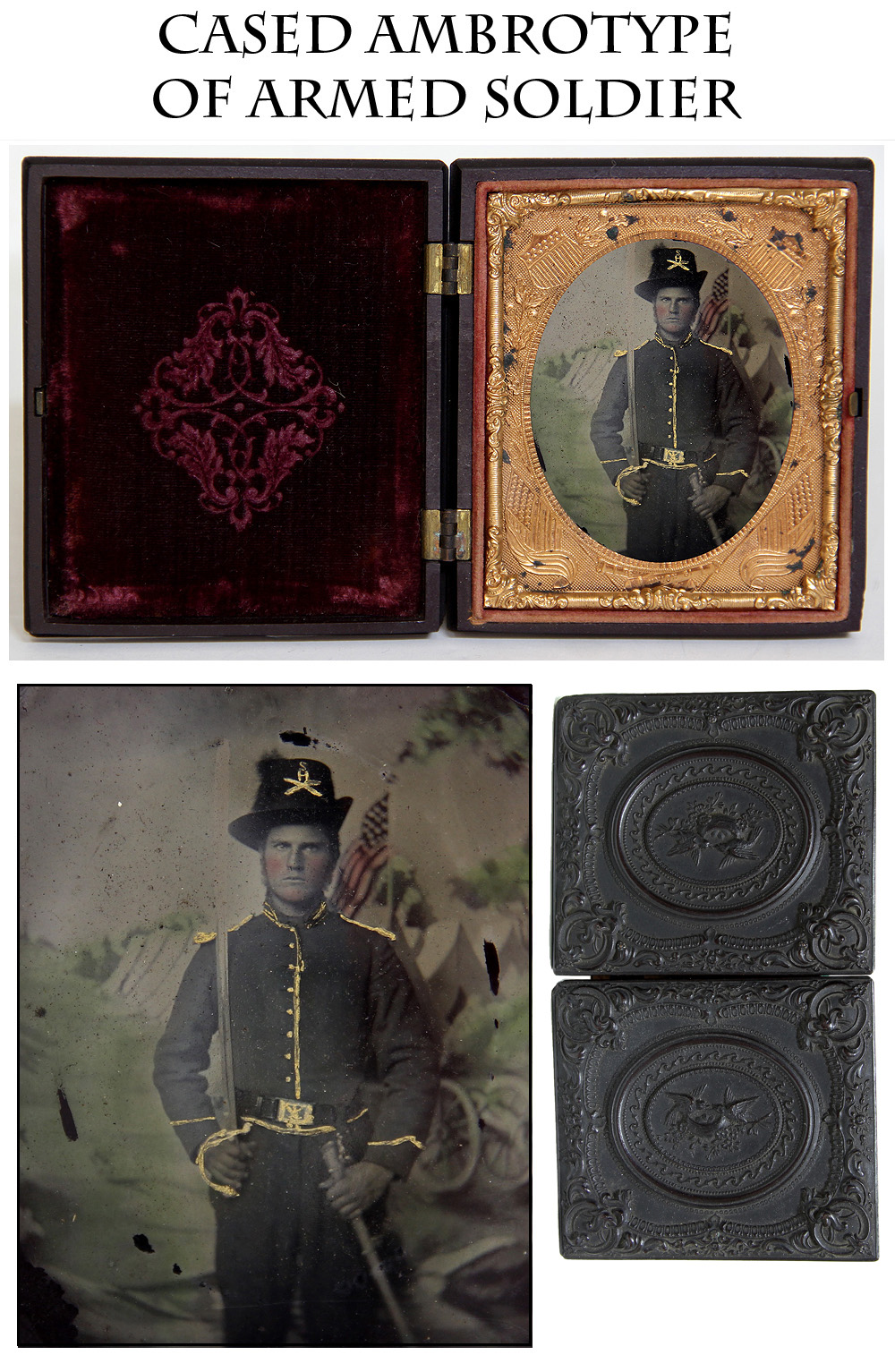
16-01-11 … SIXTH PLATE CASED AMBROTYPE OF AN ARMED CAVALRYMAN … Housed in a thermoplastic Union case showing peaceful images of flowers and nesting birds, this trooper is framed with a patriotic gilt brass matt showing American shields, crossed cannon, and United States flags. The photographer has tinted the brass elements- his buttons, shoulder scales and sword guard- and the yellow trim of his jacket, but we see a reversed “5” over an “H” and crossed sabers on his regulation Hardee hat indicating his cavalry regiment and company. He has reversed his accouterments to make his saber appear on the correct side and holds it unsheathed for the camera, with his other hand grasping the scabbard. The photographer’s painted backdrop shows a military camp with tents, a cannon in front, and a US flag flying over our man’s shoulder. The flag, trees and background have been nicely tinted as are the man’s cheeks. His face is very clear and shows a determined expression for the photographer. Some minor speckling and a couple of rub marks that do not affect the subject. The case is good, with very minor corner wear and a nice deep red velvet facing pad. The case is easily worth $75 to $100 … Xbjjz … $345.00 – SOLD
Call us @ 419-842-1863

16-01-12 … WONDERFUL CASED DOUBLE AMBROTYPE EARLY WAR PORTRAITS OF JAMES A. LOSTETTER, Co. B, 100th PENNSYLVANIA—THE “ROUND HEAD REGIMENT” … A very strong and appealing pair of images showing the same soldier in both photos. Our man appears to be in his early 30s and wears a short gray jacket with brass buttons and dark piping on collar edge and cuffs, as well as dark stripes on his trouser legs- a typical uniform of early-war volunteers north and south. In the left image he is seated alone next to a small table, resting one arm on top of a closed book. The accompanying image is astoundingly sharp and detailed, showing him seated next to an older man with strong family resemblance. The civilian is wearing a fancy suit of clothes that is clearly a decade out of style. My guess is that this is father and son circa 1861 or 1862, with Pa wearing his absolute best duds … the ones he bought way back in 1850. We were not very hopeful about being able to identify the soldier based on the inscription inside the case. But our top man (Steve Rogers) figured it out in top notch fashion. The identity of the soldier is established by the period pencil inscription inside the case written by, or for, his young daughter: “Miss” is written in one direction, and in the other is, “Maud Lostetter/ Pulaski/ Lawrence/ Penna.” Pulaski is a small town in Lawrence County, Pennsylvania. Our ace researcher Steve, was just enough recovered from his holiday hangover to find her in the 1860 census of the town as the daughter of James A. Lostetter, a tailor, who enlisted at age 34 (the right age for our guy in the photo) on 8/31/61 and mustered in as a private in Co. B of the 100th PA the same day. He was wounded in the thigh at Spotsylvania on 5/12/64, and survived to be mustered out on 8/31/64. The 100th Pennsylvania spent most of its service in the 9th Corps, first seeing action on the Port Royal expedition, losing some 14 killed and 21 wounded on James Island in June, 1862. It then returned north for service in the Second Bull Run and Antietam Campaigns, where it lost another 12 killed and 58 wounded at Bull Run, and more at Chantilly and South Mountain. It went west for a time in 1863 with the rest of the corps, seeing action in Kentucky, Mississippi and Tennessee, before returning to the Army of the Potomac for Grant’s overland campaign in Spring, 1864. In that fighting it lost men at the Wilderness, some 19 killed and 74 wounded at Spotsylvania the day Lostetter was hit, and more men at Cold Harbor, Petersburg, Weldon Railroad and other engagements. During the war it lost a total of 16 officers and 208 enlistedmen in killed and mortally wounded alone, quite a combat record. As a side note, James Lostetter did not die until 1899 and his daughter Maude survived to marry, have a family, and live until 1918. She also had the foresight to preserve a pair of very strong pair of portraits of her father as he went off to war in the war gray uniform typical of early war Pennsylvania volunteers. A superb pair of early war images with great history … cjj17088 … $650.00
Call us @ 419-842-1863
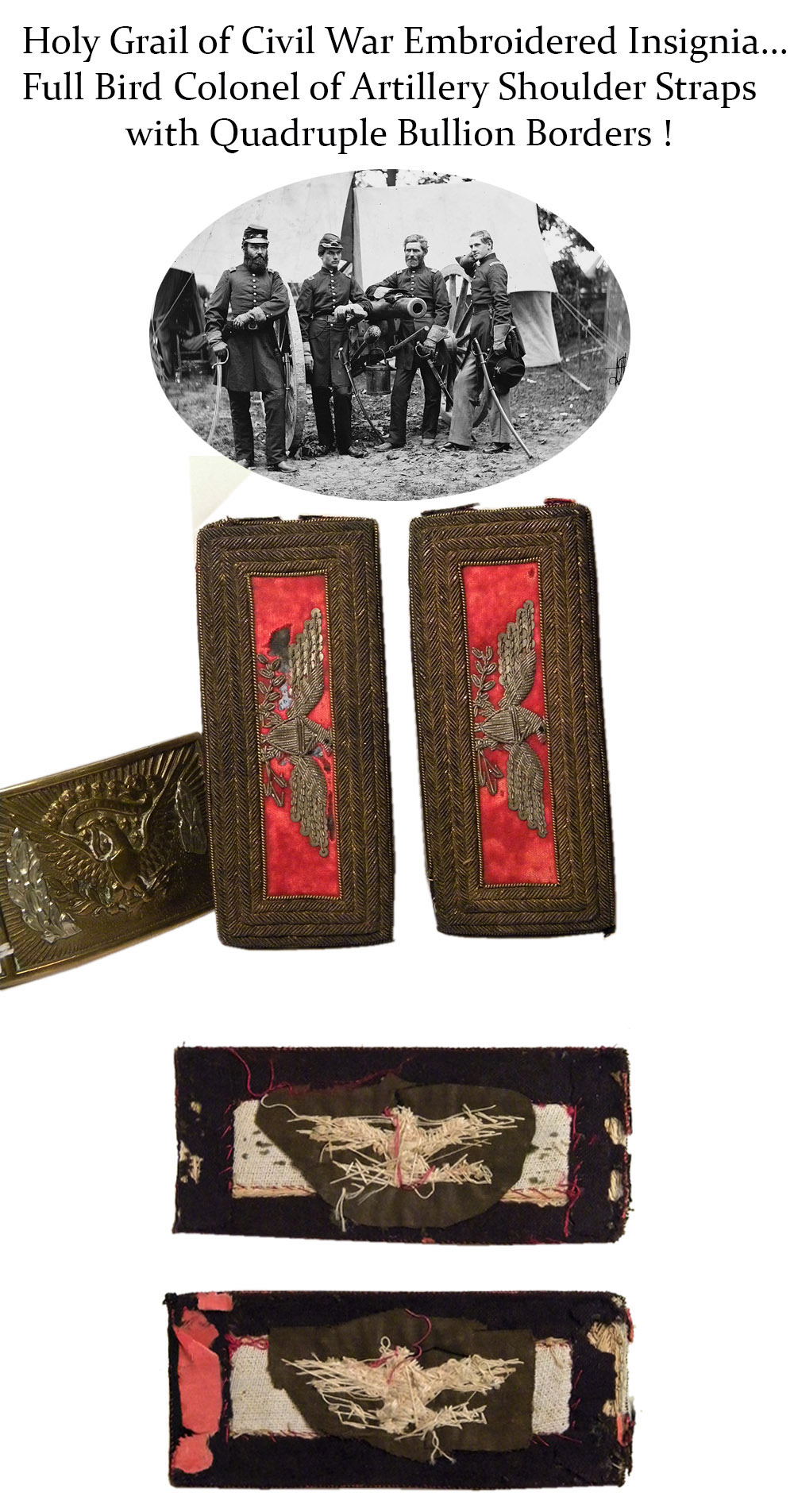
16-01-13 … MICHIGAN FOUND / FULL BIRD COLONEL OF ARTILLERY SHOULDER STRAPS / QUADRUPLE BULLION BORDER!!! … In the 45 years that I have collected Civil War artifacts this is the FIRST & ONLY set of Artillery Colonel Shoulder Straps that I recall owning. These turned up at a recent Michigan Antique Arms Show, being brought in by a man who bought them at a Detroit area garage sale! Very large size… over 5″ long and 2″ wide. These are incredibly special, as they are made with FOUR rows of embroidered bullion edge borders. Double borders are considered high quality. Triple borders are considered Extra Rich. Quadruple borders are unheard of scarce. Red velvet centers are vivid. One strap has been nipped on the red velvet by a moth or two as is shown in the photo, but not bad. There is some minor moth nipping on the dark blue backing… not of consequence, and easily concealed on display. Construction is classic Raw-Back with the embroiderer’s stitching being exposed. In the collecting world of Civil War insignia all embroidered insignia is very scarce. Even as a kid it was rare to find embroidered insignia at an antique show or flea market. Infantry is scarce. Staff insignia is scarcer. Cavalry insignia is very very scarce. And artillery insignia is downright RARE. To illustrate the rarity of Artillery insignia consider this… Here in Ohio we offered up 320,000 soldiers. 197 regiments of infantry. 13 Regiments of Cavalry. 2 Regiments of Heavy Artillery. 1 Regiment of Light Artillery. Numerous independent companies, batteries, etc of volunteers. In total Ohio had over 210 Regiments of infantry and cavalry. 210 versus 3 of artillery. Cowan’s Auctions sold a nice set with an average hat insignia for $3737.50 in 2006. If we assume these straps were worn by a Michigan officer… we could speculate that they may have been owned by Col. Cyrus Loomis… Colonel of the 1st Michigan Light Artillery. Just a possibility extrapolated from the Detroit garage sale evidence … SUPER RARE … $2,650.00 – SOLD
Call us @ 419-842-1863

16-01-14 … EMERSON AND SILVER 1862 DATED NCO SWORD … In 1840 the US army continued the tradition of designating infantry sergeants not only by chevrons, but by the carrying of a sword. The 1840 pattern remained regulation and in service all the way through the Civil War, and plenty were still in use in 1898. This is a nice example by Emerson and Silver, bearing their company name, nice 1862 date, and matching inspector’s intials DFM on the ricasso, guard and even the scabbard drag. The brass has a nice mellow patina and the blade is an even silver/gray with just some darker age gray spots near the tip. Good edge and point. Emerson and Silver also had the foresight to use a metal scabbard, which was far more robust than the leather scabbards used by other contractors. A few minor dents in the drag showing it was issued and carried, but very nice overall and still retaining its thin red washer at the blade shoulder … noco … $435.00
Call us @ 419-842-1863
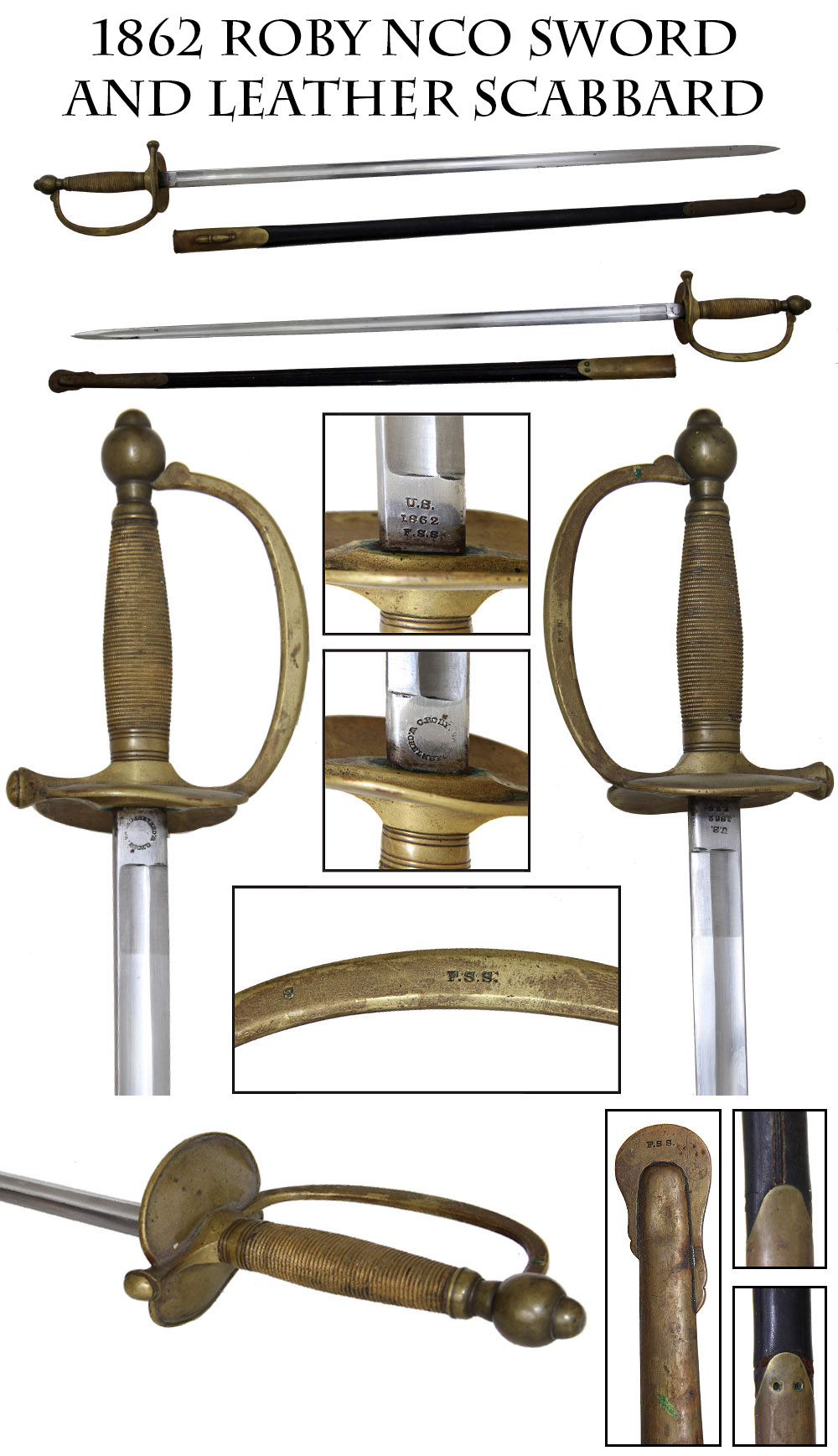
16-01-15 … 1862 DATED ROBY NCO SWORD … Another early war sergeant’s sword with an 1862 date crisp markings, just a little rubbed on one part of the circular maker’s stamp, and matching inspector marks on the ricasso, knucklebow and scabbard drag showing this sword has been together forever. Extremely nice blade in the bright with just a couple of gray spots near the tip. Good edge and point. Still shows the manufacturer’s final cross polishing of the blade on the lower portion at the ricasso. Leather scabbard rates very good but could use a bit of reinforcing above the drag where there is a crease and two small missing screws. Otherwise a superior example with an early war date to boot … noco … $435.00 – SOLD
Call us @ 419-842-1863
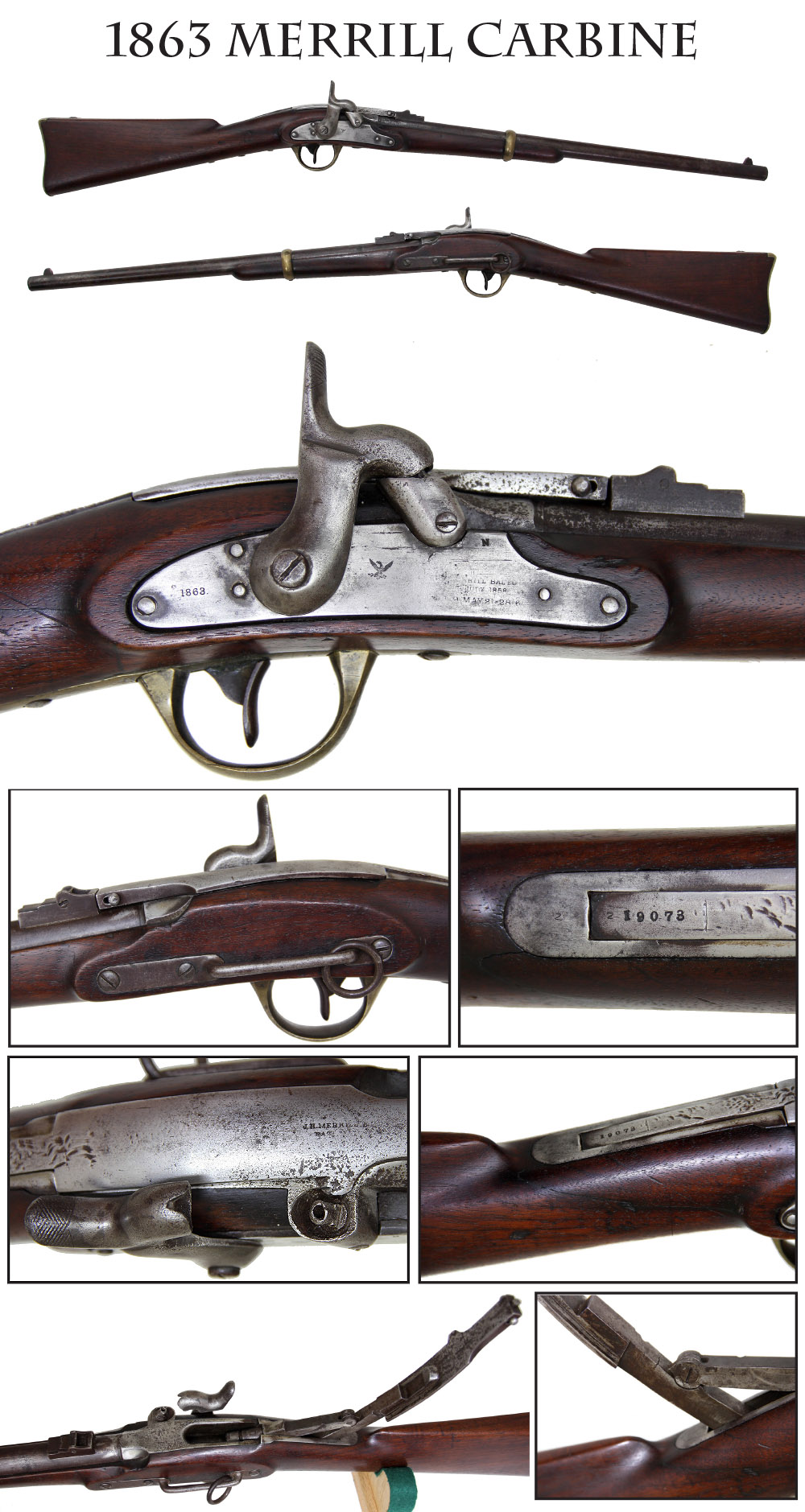
16-01-16 … SECOND MODEL MERRILL CARBINE … One of 14,500 produced by J. H. Merrill of Baltimore. It is a 54 caliber, single shot, percussion breech loading, saddle ring carbine. Both Union and Confederate cavalry are known to have carried Merrill’s. The rebs generally had first models. This 2nd model carbine has the brass trigger guard, brass butt plate, and single brass barrel band. Serial #19073 is deeply stamped on the breech lever. The breech functions by pulling back the ball shaped ends of the breech release which engages the back of the rear sight. You then lift and pull back the lever which exposes the chamber where you insert the cartridge. Top flat of the breech lever is marked with “J.H. MERRILL BALTO. / PAT. JULY 1858.” This marking worn. Marked on the lockplate forward of the hammer is the three-line address of “J.H. MERRILL BALTO. / PAT. JULY 1858 / APL. 9 MAY 21-28-61.” This marking is worn. Small spread winged eagle also stamped in front of hammer. Date “1863” stamped behind the hammer. Wood has sharp edges and a faint cartouche under the sling ring bar. The right side of the wrist has one scratch that looks like a crack, but isn’t. And it has a very faint crack that is a minor grain separation. No crack or separation whatsoever on the left side of the wrist. Gun is 100% original except for the breech release buttons which are replaced. It is 100% complete and mechanically perfect. All brass exhibits a mellow patina. Bore is VG to fine. Barrel is smooth steel with thin coffee color patina. Other steel parts are gun metal grey. Hammer has some minor pitting. Overall Very Good condition and very handsome with the brass furniture. A great mid-war carbine … a-ex-fall-#16506 … $1,695.00 – SOLD
Call us @ 419-842-1863
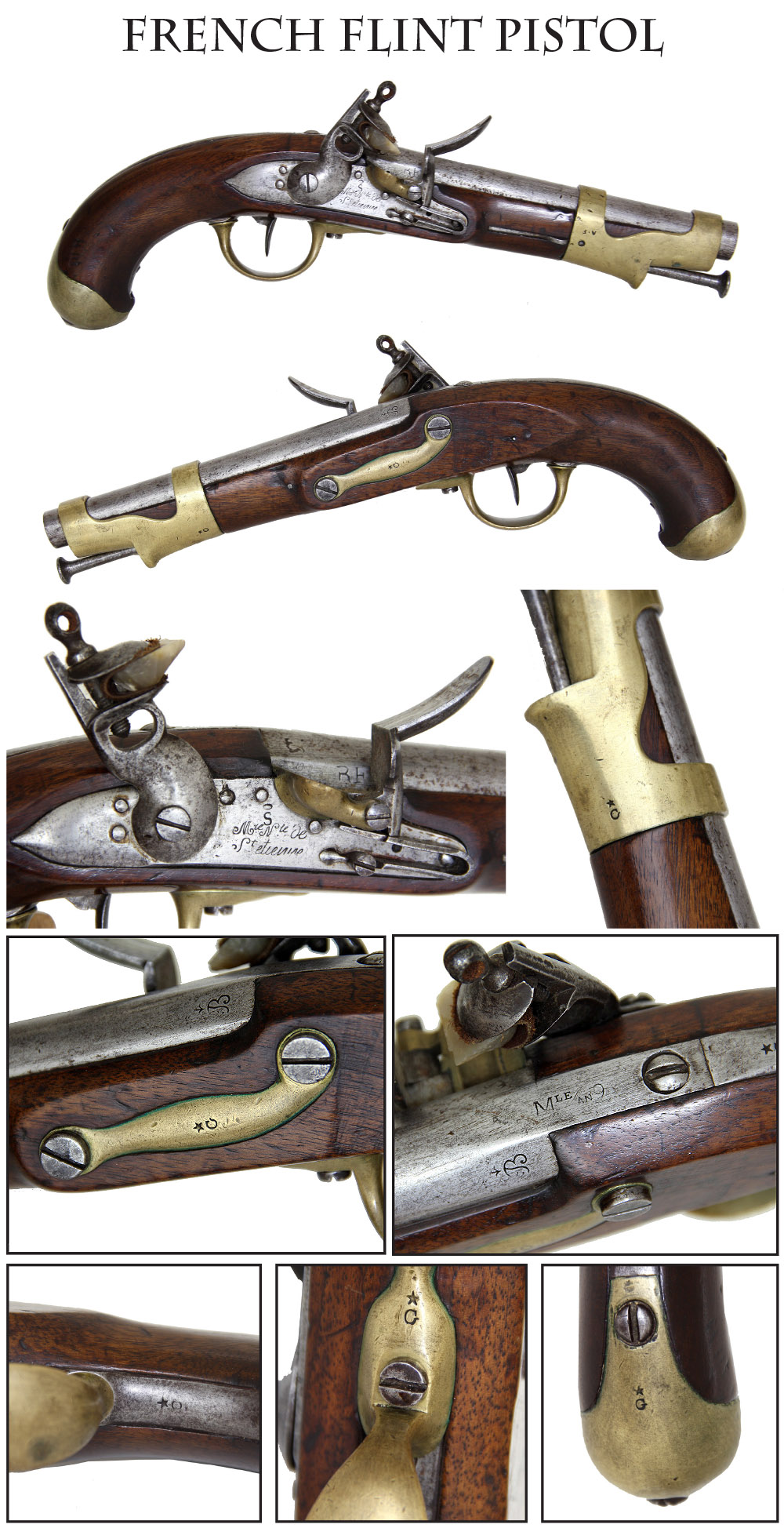
16-01-17 …SCARCE “YEAR NINE” NAPOLEONIC CAVALRY PISTOL … The “AN IX” or “YEAR 9” pattern of cavalry pistol was introduced in 1801 to replace less robust patterns and manufactured until 1806, when the “Year 13” pattern was introduced. The An IX, however, continued to be used throughout the Napoleonic Wars, sometimes updated to Year 13 specifications by altering the barrel band. This is a nice example of the “Year 9” that escaped alteration and is a great example of a Napoleonic cavalry weapon used throughout the period in its original configuration. Very clear St. Etienne arsenal markings and various inspector marks including the starred-G of Joseph Guichard, who worked there from 1793 all the way to 1826, an “S” on the lock plate for Comptroller Soviche (1798-1811), and the cursive “B” that might be Antoine Blanchon, who was at St. Etienne from 1798-1812. Medium patina to the brass band, pan, trigger guard and butt cap. Lock functional. Wood rates about excellent. Barrel, lock and hammer a smooth silvery gray mixed with bright. A superior example of a scarce Napoleonic cavalry arm. On November 2nd 2013 Skinners sold one with a replaced rod for $2,337.00. I will sell you this one for … hjj-17237 … $1,850.00 – SOLD
Call us @ 419-842-1863
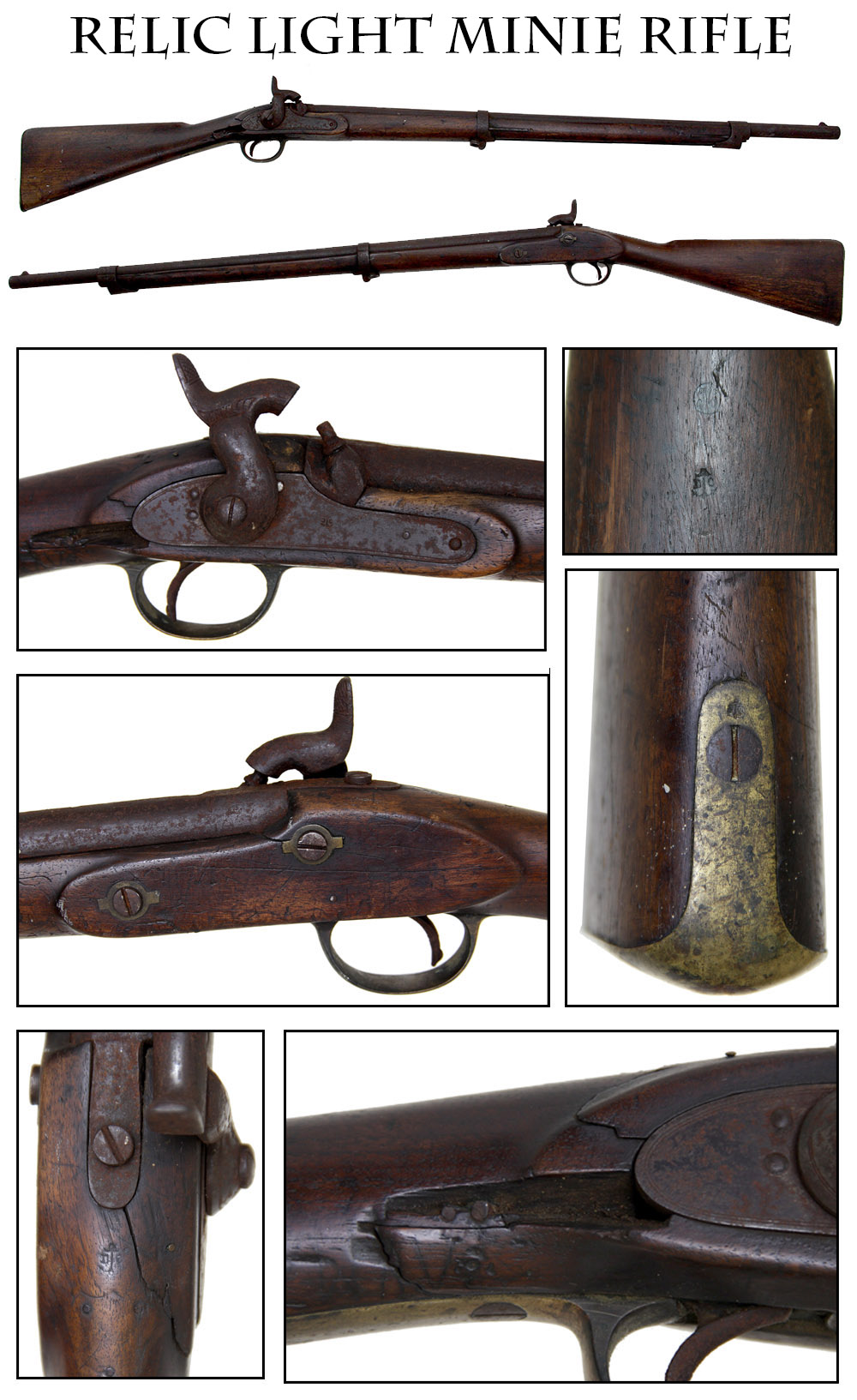
16-01-18 … RELIC BRAZILIAN LIGHT MINIE RIFLE … Well used relic version of one the most attractive of the percussion rifles used during the American Civil War. The Brazilian Light Mini� Rifle, manufactured by the O.P. Drissen company of Li�ge, was a unique combination of the features found on the British Pattern 1856/58/60 series of Enfield short rifles and the French Light Mini� rifle. It is .577 caliber and designed to take a long, straight-bladed saber bayonet. The story goes that these Belgian made guns were part of a contract destined for the Brazilian military, but some 6,000 ended up being sold to eager US buyers instead. Still visible on the top of the wrist is the “D/(anchor)/C” stamp O.P. Drissen and the outline of the classic brass shield that bore a U.S. style eagle and is thought to have been applied in Cincinnati, Ohio. (The same “D/(anchor/C” mark appears on the S&K bayonets supplied with this rifle, and on other parts of the rifles, too.) Whoever owned this rifle liked it well enough to keep it in service as long as possible. The stock cracked at the right side of the wrist and the owner simply nailed the sections back together to stabilize it, and indeed the lock still functions. Aside from the repair, the wood is actually pretty good and still shows the D/anchor/C and even one lighter cartouche. There is no rod or rear sight, and the metal becomes quite crusty toward the breech. The lock plate shows raised rust, but there is still color showing on the barrel and plate. I would not try to do much with this rifle. It is cool just the way it stands. A great old relic rifle … $435.00 – SOLD
Call us @ 419-842-1863

16-01-19 … G.W. KEATING’S PRESENTATION MATCH CASE … An antique with interest to Law Enforcement collectors and Civil War nuts. Nicely engraved silver match case with folding cover. Engraved with floral motifs on one side and “G.W. Keating / From/ Police Force/ after serving/ 40 Years.” Seems like a rather slight token for 40 years of service, but perhaps they included some matches with it. Keating had served in the 174th New York, which recruited in New York City, had the 5th NY Militia as its nucleus, and was organized “under the auspices of the Metropolitan police” (Phisterer.) He enlisted and was commissioned Captain at age 30 on 10/17/62. The regiment was sent to the deep south and took part in the siege of Port Hudson as part of the 19th Corps, where it lost 14 men in killed, wounded and missing. Keating had command of the regiment in July during the engagement at Bayou LaFourche, sometimes called Donaldsonville, Cox’s (or Kock’s) Plantation, where it lost 18 killed, 29 wounded and 7 missing, the heaviest loss of any regiment in the engagement. During its service the outfit lost 1 officer and 22 men killed or mortally wounded.
In February, 1864, the regiment was consolidated with the 162nd New York, another New York City outfit recruited under the auspices of the police, and Keating was promoted to Major of the regiment on 2/17/64. He served in that capacity for four months, but was discharged for disability on 6/9/64. He is also carried on the rolls as Washington Katen. We can extrapolate from this that his full name was George Washington Keating … that he sometimes went by Washington and some sub literate record keeper phonetically spelled Keating as Katen. There is some indication he spent time with the 37th NY National Guard as well, but the time frame is unclear. Both the 174th and 162nd Volunteers, however, had clear connections with the police. A cursory search shows a George W. Keating as a policeman in Utica in 1899. If it is the same man, he was put forward in the state assembly for a pension and turned down. I guess they figured a match case was enough … aej-17088 … $245.00 – SOLD
Call us @ 419-842-1863

16-01-20 … MODEL 1837 FRENCH PERCUSSION NAVY PISTOL … Fine single shot percussion pistol in the bright with very clear Tulle manufactory lock plate engraving and an 1839 date of manufacture on the right breech flat. Tulle supplied arms to the navy and there is a nice anchor mark in the brass butt cap. On the left side is a great belt hook that is typical of boarding pistols of all navies, making it convenient to hand these guns out to boarding parties just before going into action so the men can hang them from their waist bands. Smooth bright metal overall with crisp markings. Captive ramrod so the sailor won’t lose it if he gets a chance to reload in the fray, and a lanyard ring in the butt to make sure the pistol won’t get away if he drops it while climbing aboard an enemy vessel. Very minor dings or scratches to the wood, a couple of chips around the upper edge of the lockplate, otherwise extremely clean and a great example. Priced way below other dealers. Do a Google search and see for yourself … djjs-17237 … $695.00 – SOLD
Call us @ 419-842-1863

16-01-21 … SPENCER INFANTRY RIFLE /SPRINGFIELD ALTERATION FROM CARBINE … One of only 1,108 such guns produced circa 1871. Springfield took the M1865 Spencer carbines and altered them to 2-band infantry rifles. This one overall VG condition. 100% original 100% complete except for sight leaf, and mechanically perfect. All markings clear. Serial number 4522. Wood has been varnished. Steel surfaces mostly smooth gray steel. Some spots of pitting on left side of frame, not offensive. Has proper rod and proper rear sight but rear sight lacks the elevation leaf. A darn scarce Spencer arm and perfect for early Indian War display. Great bore … ajjj-15-11-28 … $1,495.00
Call us @ 419-842-1863

16-01-22 … SAMURAI SWORD … Nothing testified to one’s service in the Pacific like a samurai sword in the duffel bag on the way home. This is a low end 20th century example with a tsuba that is terribly crude… Overall mediocre condition with the leather peeling from the scabbard at the ends and very minimal decoration. Still, the grip wrap is there over the sharkskin grip and the blade has some shine to it, so it looks pretty good displayed. The edge of the blade has been dulled. Cool display relic … b … $250.00 – SOLD
Call us @ 419-842-1863
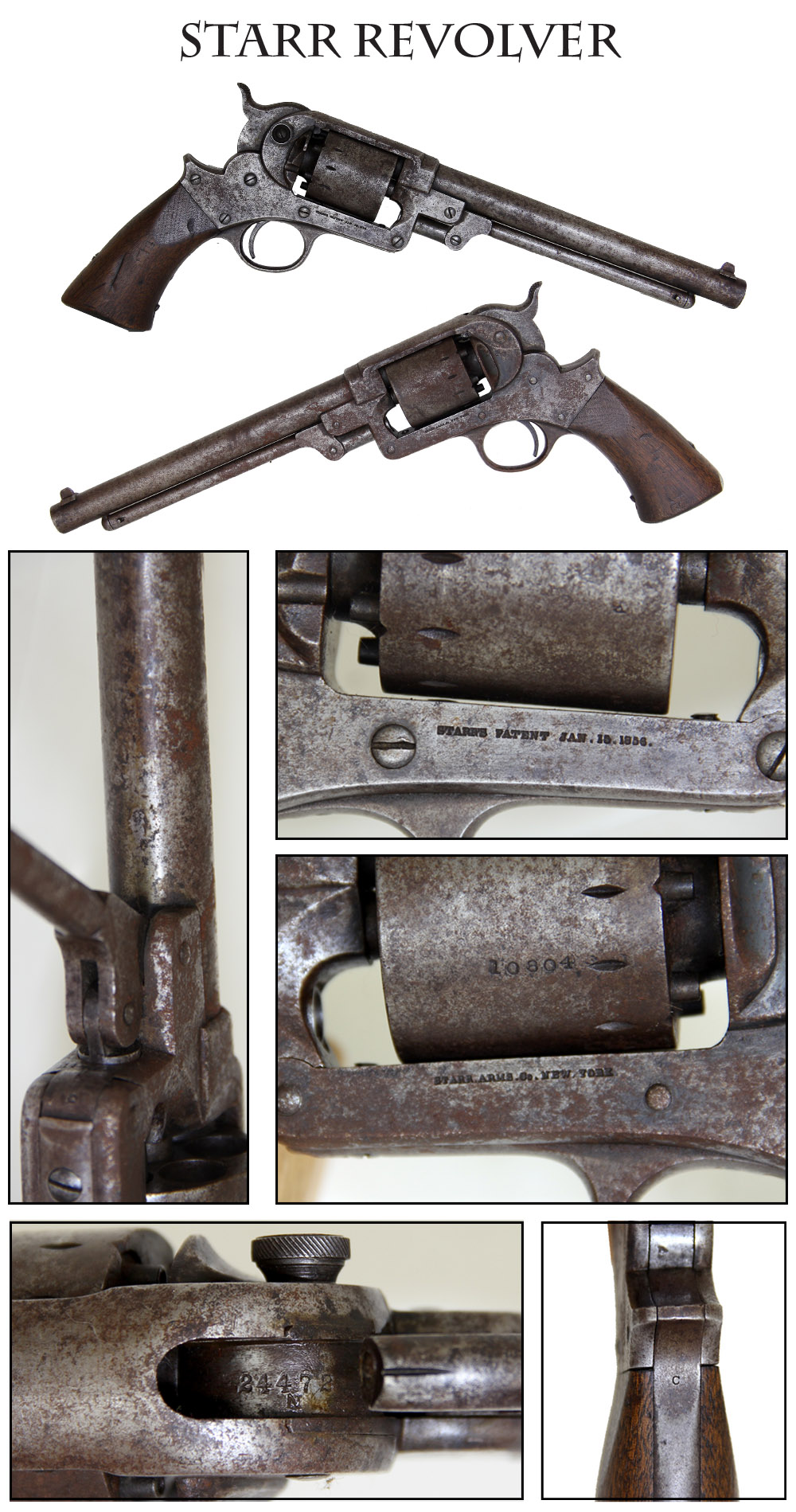
16-01-23 … SINGLE ACTION STARR ARMY REVOLVER … The Starr double actions were too far ahead of their time- at the very least the trigger pull would throw off any chance of hitting your target. The single action was more conventional and replaced it mid-war. This one was obviously “ridden hard and put away wet,” showing gray underneath a generous surface dusting of brown. Much of this would clean easily, but of course most of the bluing is long gone. Still, the markings are crisp and the wood, though it has some dings, still has a tight fit and shows a visible cartouche. The cylinder shows serial number 10804 and the loading assembly 24472, so the gun was plainly issued and the assembly switched over a campfire cleaning. I see mixed numbers on these stars about 35% of the time. Overall a solid “gun metal grey” gun … h-1/2-szym … $1,195.00
Call us @ 419-842-1863

16-01-24 … UNION ARMS COMPANY PISTOL WITH SOME BLUE … These pistols are usually attributed to W.W. Marston of New York City, who used a number of different company names. Typical bag shaped walnut grips, barrel going octagon to round, 4-inch barrel. Very nice condition for one of these pocket pistols. The barrel shows lots of faded blue, the markings are crisp, and there is even some faint mottling on the frame that shows old case color. A very simple pistol, unlikely to get out of order when the owner needed it in a hurry. Caliber .31 enough to deter an opponent. A nice high finish gun … bej-120912-ex-mik … $565.00 – SOLD
Call us @ 419-842-1863

16-01-25 … M1855 US SPRINGFIELD RIFLE MUSKET … A solid and 100% original ’55 musket with the Maynard tape priming system. This gun was brought into the shop by a local man. His dad bought it in 1949 when he was taking a gunsmith class. At the time the gun was only 90 years old, and there were still a handful of CW vets still among the quick. Dad and son shot the gun for many years. The musket is 100% original and 100% complete. It is mechanically perfect, and very handsome. The only alteration is the addition of a tiny bead at the back side of the original front sight. See illustration. The dates on lock and barrel are matched “1859”. The bore is excellent. The only wart is that dad refinished the stock to show the gunsmith class. This looks great but in the process the inspector’s cartouche was lost. These 1855 arms were the first .58 caliber rifles and rifle muskets and the first to incorporate the unreliable Maynard tape priming system which utilized a roll of paper caps (like in a child’s cap gun) to function as the primer. This is the so called transition 1855 with the type-2 short range rear sight, and the type-1 brass nosecap and no patchbox. Harpers Ferry produced type-2 ’55s with steel patch boxes. Some early type-2 Springfields are known with patch boxes, but the vast majority of type-2 Springfields do not have them. A solid and affordable example of a scarce US martial longarm. Used by both North & South … raajjq-1512?? … $2,195.00
Call us @ 419-842-1863

16-01-26 … WATERS M1816 CONVERSION MUSKET IN ATTIC BROWN CONDITION …
Super handsome with sharp edges on the stock. Stock rates fine, balance rates VG. 100% original including the ramrod. 100% complete. Mechanically perfect. Lock dated 1836 Barrel tang dated 1837. Cone-in-barrel conversion done at arsenal. All the metal is a deep attic rust brown patina, very handsome. About as honest a gun as you could hope to find. Original owner’s initials carved into the bottom side in classic mid 19th style. I got this at a local auction for three hundred bucks !!! so I can sell it “right”….. Super gun … cjj … $795.00 – SOLD
Call us @ 419-842-1863
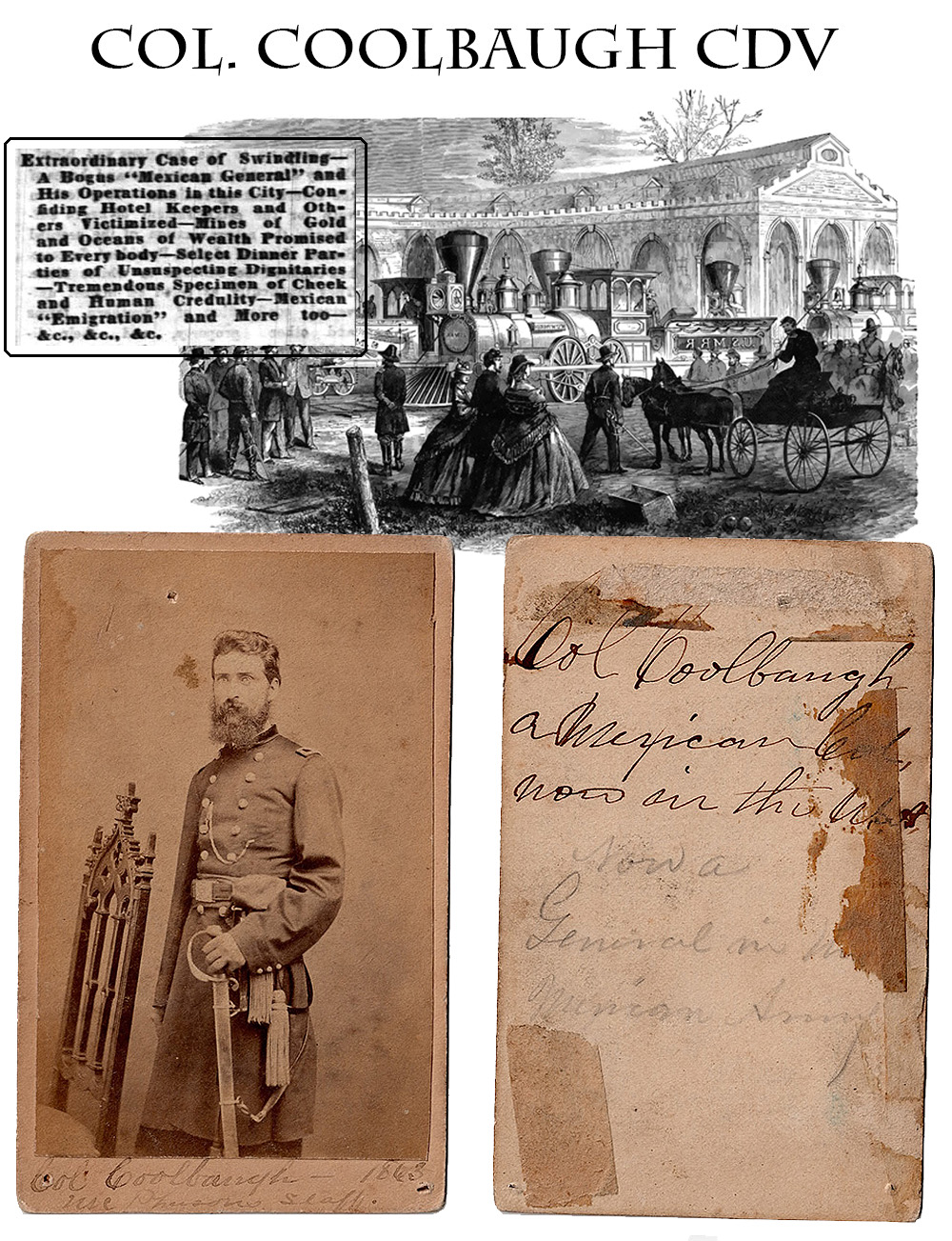
EPSON MFP image
16-01-27 … HE RAISED THE FLAG AT VICKSBURG … WAS FRIENDS WITH MCPHERSON … WAS GIVEN A HIGH GRADE COLT BY ROSECRANS … WAS A THRILL SEEKER… WORLD TRAVELER … SOLDIER FOR THREE NATIONS … WAS AN ACCOMPLISHED CONFIDENCE MAN WHO LIVED THE LIFE OF A MILLIONAIRE … AND HE RAN AN ARKANSAS PRISON AS A CONVICT… MEET COLONEL COOLBAUGH OF MCPHERSON’S STAFF …
One of the rarest and most interesting Civil War photos I have owned. In the 40+ years I have collected CW photos I have never seen another image of this high ranking officer offered for sale. I have found few men with a more interesting story in which it is tough to untangle fact from fiction than Colonel George Nyse Coolbaugh. Here is striking image of one interesting character! Three-quarter length standing view of a bearded officer in frock coat with sword, sash and belt. Field grade frock with the tip of his “full-bird Colonel” strap showing. Identified in period ink at bottom as “Col. Coolbaugh � 1863/ McPhersons staff” in the same hand as others from this album kept by a photographer employed by Barr and Young. On the reverse is another period ink inscription in the same hand reading “Col. Coolbaugh a Mexican Col., now in the U.S.A.” and below that in pencil, “now a general in the Mexican Army.”
George Nyse Coolbaugh was brother of a prominent Chicago banker who committed suicide in 1877, some said largely out of shame at George’s actions. George was supposed to have been in the British army during the Indian Mutiny, taking part in the storming of Delhi, and receiving a resolution of regret at his departure by his superior officers when he left the service. However, he had such a reputation as a confidence man after the war that it is difficult to discover the truth of his biography. He apparently believed in living large. He went to Mexico after his British adventures, joined the Mexican army of Juarez and then came north on Mexican government business in 1862, with a pocket full of gold. He definitely had some railroad experience, being described as a General Railroad Freight Agent, and was made an acting aide on McPherson’s staff in 1862 when McPherson was made superintendent of railways in West Tennessee. His expertise in orchestrating the transportation of men and supplies must have come in handy, for he remained with McPherson and the two became fast friends. At the surrender of Vicksburg in 1863 Coolbaugh was one of two officers sent by McPherson to unfurl the 17th Army Corps Headquarters garrison flag from the courthouse. One regimental history recorded it as follows: “When all arms had thus been stacked, General McPherson attended simply by his division generals and staff rode into the city. He proceeded at once to the courthouse where Colonel Coolbaugh and Lieutenant Colonel Strong ascended to the cupola, and, at half-past eleven, displayed thence the “Stars and Stripes,” greeting them with three cheers which were responded to by the officers below, and then all joined in singing, “The Battle Cry of Freedom.” [Hist of 7th RI] Coolbaugh’s railroad expertise came in handy after the taking of the city as well. A Harpers Weekly illustration of the period shows five locomotives built by Union soldiers in Vicksburg under Coolbaugh’s supervision.
Coolbaugh, though, was equally adept at lining his own pockets (as was General Hurlbut, whose photograph was also found in this archive.) While he was in Corinth, Governor Sprague of Rhode Island showed up looking to buy cotton and Coolbaugh fronted $20,000 to buy it at 7 to 9 cents a pound in gold, which gave them a good mark-up since it sold at 15 cents a pound in greenbacks. It was a deft maneuver and Coolbaugh was made an honorary Lieutenant Colonel without pay. He believed in spreading good fortune, however, and later presented McPherson a Tiffany sword valued at $1500 and Grant a set of saddle mountings worth $2500. By September, 1863, however, his actions seem to have caught up with him. Assistant Adjutant-General Bowers, a close friend of Major Rawlings on Grant’s staff, did not like him and his shenanigans jeopardized McPherson’s promotion to brigadier general in the regular army. Coolbaugh determined to return to Mexico and was given a good send off, but stopped in St. Louis and there started recruiting for the Mexican army, a short-lived project since the Mexican government of Maximilian was sympathetic to the Confederacy. He did, however, meet and marry one Jennie Williams in that city, supposedly a respectable woman at the time, but who was said later to operate a “bagnio” (i.e. brothel) in Chicago. In the meantime, they headed to New York, Coolbaugh in a Mexican general’s uniform.
Billing himself as “Major General Coolbaugh of the Mexican Army,” he appeared in New York City in March, 1865, and took rooms with a woman “his wife, or a lady who passed for his wife,” at the Courtlandt Street House and represented himself as a very wealthy representative of the Mexican government looking for personal investment opportunities. One of his triumphs was to host a dinner party that included the Mayor and ran up a sizeable bill that Coolbaugh examined and declared was not high enough, since it would be paid by the Mexican Government. He represented that not only was he very wealthy, but his wife was from a rich family as well, and that he had a prosperous farm in New Jersey. Needless to say, he was never quite ready to draw out the gold he said was on deposit in the local bank and managed to borrow some $537.87 from the hotel proprietor before skipping town, and eventually being arrested in St. Louis and brought back to New York for trial in 1866.
His penchant for living large was exhibited again in 1873. Temporarily postmaster in Clarksville, Arkansas, he was found guilty of purloining one dollar from a letter, he was sentenced to a year in prison, but denounced the judge and jury and demanded the stiffest sentence if he was guilty. The judge obliged and sentenced him to seventeen years. The prison at Little Rock, however, was privately controlled by a man named Hodges, who eventually made Coolbaugh the prison’s business manager, allowing him to live outside the prison and wear civilian clothes. He quickly became known as one of the best dressed men in town driving “the most sumptuously accoutered buggy in the place.” Appeals for a pardon from Grant, however, went unanswered.
Of some note in terms of current day connections … Coolbaugh’s ultra high-grade, Gustave Young engraved, presentation Colt revolver was sold at Bonham’s a few years back. The gun was presented to him by Gen. Rosecrans. Another mystery to solve. Bonhams had a pile of research on him. The one tid-bit Bonham’s shared in their description was that family tradition said he died at the hands of Confederate sympathizers in revenge for his actions aiding the Union. As they say, this is an image worthy of further research! Who owns his revolver???? … $850.00
Call us @ 419-842-1863

16-01-28 … ARMED IMAGE OF SERGT. DARIUS CHAPIN 1st NY ARTILLERY … Chapin was older than average- he enlisted at age 42 on 8/23/61 at Russell, NY, and was mustered in as a private in Battery D of the First NY Artillery on 8/30/61. This regiment served mostly as independent batteries of light artillery. Russell made sergeant 9/6/61. His chevrons show clearly in this nice full standing portrait and he probably had it taken to commemorate the event. He was subsequently made Quartermaster sergeant and then received a commission as 2nd Lieutenant of Battery L on 4/23/64 and 1st Lieutenant of Battery B on 2/1/65. He acted as regimental quartermaster at some point, but no dates of that service are given. He was mustered out with the regiment 6/21/65.
He is nicely posed in a studio leaning against a column with his gloves in one hand, a cavalry saber hanging from a cavalry belt rig on his waist, and a pistol thrust prominently into the belt. A nice period pen identification on the reverse reads: “Uncle Darius Chapin of Rossell N.Y.” Battery D served in the 3rd and 9th Corps; Battery L was Reynolds Battery from the Rochester area that served in the 5th Corps and then the Artillery Reserve during Chapin’s tenure with it. Battery B, his last assignment, was Pettit’s old battery, a hard-fighting Second Corps unit that was in the Artillery Reserve and then the Fifth Corps when Chapin was assigned to it. A strong image of soldier with some service … $250.00 – SOLD
Call us @ 419-842-1863

16-01-33 … 1825 DATED SPRINGFIELD MODEL 1816 … An expert reconversion, back to flintlock, of a Springfield 1816 that is in nice condition. The breech shows the characteristic line where a special patent breech was fitted when the gun was altered to percussion. At some point a collector liked the condition well enough to have it put back in flint. It would be a great gun for a reenactor to use, or a great collector item just to impress your friends. All metal parts in the bright, but toning slightly so it does not appear merely over cleaned. Crisp lock markings, a tad light on the 1825 date and the eagle, but not bad. Visible cartouche on the offside. Good wood to metal fit. Minor chipping at the plate edge. Bands, swivels, springs, etc. in place. Rod is a trumpet style rod for the 1842 rifled and sighted musket with recessed dish in the tip. This rod is likely worth a couple hundred bucks by itself. A nice looking musket. Here’s a New Year’s bargain for you … $795.00 – SOLD
Call us @ 419-842-1863

16-01-35 … BACON 2nd MODEL POCKET REVOLVER w/ FOUR INCH BARREL …
Made c. 1858-67. Approximately 3,000 made. The top of the barrel is marked “BACON MF’G CO. NORWICH CONN” Condition NRA VG to Fine with generous traces of original blue on the cylinder and in protected areas. Very early three digit serial number 560. Grips retain 80% original varnish. All original and fully functional. An extra nice example and a fine buy at … xeejz … $695.00 – SOLD
Call us @ 419-842-1863

16-01-37 … INCREDIBLY EFFECTIVE LIGHTED MAGNIFYING GLASS / PERFECT FOR INSPECTING ANTIQUES … You have undoubtedly seen collectors at the shows running around with one of these magnifying glasses in their hand. There’s a good reason … they are SUPER! Months ago I bought one for myself and loved it. Then the local guys wanted one and I bought another half dozen for them at $25 each at the next show … Then I bought another one for me when I arrived at a show and discovered I’d left mine at home. I figured with as many as I was buying at retail, I might as well buy them in bulk and sell them at the shows and on the web page. These are absolutely essential for anyone buying antiques at shows or auctions. The intense illumination from the twelve LED light sources and 2x magnification exposes “artificial age” such as cold-blue on metal or amber shellac on wood. Shine this light and you will see if someone has “aged” or repaired the item you wish to buy. The magnification accompanied by the intense illumination reveals cracks and repairs that the naked eye cannot pick up. Requires 3 AA batteries (not included) … $25.00
Call us @ 419-842-1863
Layaways are Welcome
Need to split your order into multiple payments? No problem! A simple 20% earnest money deposit will hold your item for you.-acf
You can then pay it off in easy installments that fit your budget.
Read Terms Here
Items to Sell? Contact Us
I am always interested in buying ANYTHING from the American Civil War… Guns, Swords, Civil War Muskets, Knives, Uniforms, Flags, Medals, Badges, Diaries, Letters, Autographs, Buttons, photographs, tintypes, daguerreotypes, Insignia, Camp Items, Battlefield Relics, canteens, Drums, Etc… Call 419-842-1863 and ask for Dave Taylor.

